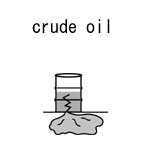| Case Name |
Leakage of water contaminated with crude oil from a corroded part of piping during removing operation of unnecessary piping left for a long time |
| Pictograph |

|
| Date |
October 31, 1990 |
| Place |
Kawasaki, Kanagawa, Japan |
| Location |
Refinery |
| Overview |
On October 31st, 1990. To remove unnecessary piping at an oil refinery, an attempt was made to remove residual oil with pressure. Oil leaked from the corroded part of the piping. As crude oil that contains water remained in unnecessary piping, the piping had corroded. Unnecessary and unused piping complicate a piping system, and can cause an operation mistake. Moreover, it can become a hotbed of leakages due to corrosion or breakage. |
| Incident |
Crude oil leaked on removing unnecessary piping at an oil refinery. The piping was used for transfer to a refining unit from a crude oil tank. It had not been used for about two and a half years. Before removing the unnecessary piping, the piping was pressurized with nitrogen to remove residual oil in the piping. Water containing crude oil leaked from the corroded part of the piping in a tunnel under a road. Refer to Fig2. |
| Processing |
Manufacture |
| Individual Process |
Maintenance |
| Substance |
Crude oil |
| Type of Accident |
Leakage |
| Sequence |
On October 31st, 1990, 09:30. Drawing-off of remaining oil in piping started prior to the piping removal.
10:25. The piping was pressurized with nitrogen.
10:35. Pressure reached 0.1 MPa. Pressure rise was stopped and there was no abnormality. Transfer of the remained oil started, opening the block valve of the tank gradually.
10:45. Pressure reached 0.2 MPaG. There was no abnormality.
10:50. Leakage of water that contained crude oil was found during patrol. The pressure at that time was 0.26 MPaG.
10:55. Pressurizing with nitrogen was stopped immediately, and the block valve of the tank was closed. A report was made to the related sections.
11:00. An emergency call was made to the public fire department.
11:05. The pressure in the piping was released and recovery of crude oil in a tank yard began.
11:50. Although a rubber belt was wound around the piping, the leakage did not stop. Leaked oil was collected.
12:43. When metal cement was applied and the rubber belt was rolled again, the leak stopped. |
| Cause |
The piping was not used with water containing crude oil remaining in it. Therefore, sludge etc. precipitated in the piping and internal corrosion advanced.
The scale accumulated on the corroded part was removed by the transfer, and a hole opened. |
| Response |
The valve was closed and the pressure in the pipe was lowered. Metal cement and a rubber belt were used, and the leakage stopped. It was reported to the public fire department. |
| Countermeasures |
Unnecessary piping should be removed.
If piping is not used, the contents are drawn off and the piping is separated from the parts in use with a blind plate.
Furthermore, the piping is filled with nitrogen gas.
If the drawing-off of the content cannot be done, the measurement of the wall thickness of the piping should be done once every two years. |
| Knowledge Comment |
Unnecessary piping should be removed.
Unused piping is separated from the piping in use, and is filled with nitrogen gas.
Daily checks are not neglected when the measures above cannot be done. |
| Background |
Removing of piping requires much money. Moreover, it might be useful in the future. Even if it is unnecessary, it is not removed in many cases. In such a case, to decrease expenses, purging and maintenance are often neglected. This case is such an example.
There is little consciousness that corrosion will occur in the future. |
| Reason for Adding to DB |
Example of corrosion of unnecessary piping left for a long time |
| Scenario |
| Primary Scenario
|
Organizational Problems, Poor Management, Slackness of Management, Poor Value Perception, Poor Safety Awareness, Inadequate Risk Recognition, Usage, Maintenance/Repair, No Inspection, Failure, Abrasion, Corrosion, Secondary Damage, External Damage, Leakage
|
|
| Sources |
The Kawasaki City Dangerous material safety research association. Accident case that is useful at present. Examples of accidents at a dangerous facility (with FTA), pp.122-124 (1997).
Kawasaki City Fire fighting station. Prevention division. Peace section, Material of the Kawasaki City Complex safety countermeasure committee.
|
| Physical Damage |
About 800 L of crude oil |
| Multimedia Files |
Fig2.Simplified flow sheet
|
| Field |
Chemicals and Plants
|
| Author |
ITAGAKI, Haruhiko (Japan National Institute of Occupational Safety and Health)
TAMURA, Masamitsu (Center for Risk Management and Safety Sciences, Yokohama National University)
|